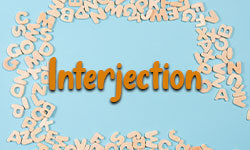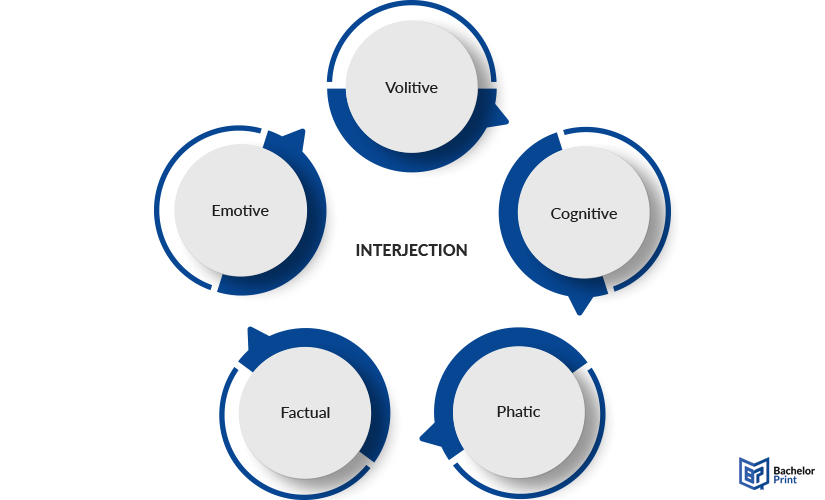
Interjections stand as one of the most expressive elements within the tapestry of language, serving as linguistic tools. Unlike other parts of speech that contribute to the grammatical or semantic sentence structure, exclamations are unique in their ability to stand alone, encapsulating complex emotions or responses in a single word or phrase. This article delves into the vibrant world of common interjections, exploring their definition, classification, and the roles they play in communication.
Definition: Interjection
An interjection is a word or a phrase that expresses sudden reactions in the form of a short exclamation. They can range from shock and pain to joy and greeting. There are no grammar rules when it comes to exclamations; you can use them before or after a sentence that explains what’s going on, and they can end with different punctuation marks depending on the emotion they want to convey.
When used in spoken language, they typically accompany non-verbal cues, enriching the speaker’s message with layers of meaning. In written form, their use becomes more nuanced, particularly in genres that allow for a personal voice, such as creative writing and informal communication.
In the context of academic writing, the use of English exclamations is generally avoided, as the tone is expected to be formal and objective. They can introduce subjectivity and casualness that are not typically suited to scholarly discourse.
There is also a famous animated musical by Essra Mohawk called “Interjections!” that was featured in a “Schoolhouse Rock!” series in the 1970s. It’s a series of short videos illustrating various songs that teach multiplication tables, grammar, science, American history, computers, economics, and environmentalism.
Common examples
Below, you will find numerous examples in the form of a list of interjections that are used in the English language. They can cover a broad spectrum of spontaneous emotional expressions, from joy and surprise to disgust and pain, and are used in both formal and informal contexts.
| Interjection |
|---|
| Ah |
| Aha |
| Ahem |
| Alas |
| Bingo |
| Boo |
| Bravo |
| Brrr |
| Eek |
| Eh |
| Eureka |
| Fie |
| Gee |
| Gosh |
| Ha |
| Haha |
| Hey |
| Hi |
| Hmm |
| Hooray |
| Huh |
| Hurrah |
| Ick |
| Meh |
| Mmm |
| Nah |
| No |
| Nope |
| Oh |
| Oho |
| Oi |
| Oof |
| Oops |
| Ouch |
| Ow |
| Phew |
| Psst |
| Shh |
| Sigh |
| Uh |
| Uh-huh |
| Uh-oh |
| Ugh |
| Um |
| Whoa |
| Wow |
| Yay |
| Yeah |
| Yep |
| Yes |
| Yikes |
| Yippee |
| Yo |
| Yuck |
| Yuh-uh (Yes) |
| Yum |
| Zap |
Primary and secondary interjections
Exlamations, those spontaneous bursts of emotion or reaction in language, come in two distinct versions: primary and secondary. In this section, you will find out more about them, as well as examples.
Primary
Primary interjections are words created specifically to express emotions or reactions. They can stand alone, untethered to the grammatical structure of a sentence. They are typically sounds without a clear etymology, and may be written in different ways.
Types of interjections
English exclamations can be categorized into different types based on the functions they serve, or the emotions they express. Here are some of the primary types, along with their examples.
They express personal feelings or emotions of the speaker. They are often instinctive reactions.
They express a wish or a command and can be used to invoke an action or express a desire.
Cognitive interjections reflect mental processes or sudden realizations, often critical thinking or understanding.
They are used to manage the flow of conversation, such as starting, maintaining, or stopping a dialog.
The factual type comments on the state of the world or an immediate situation, often stating a fact or an obvious truth.

Role of interjections
Their role in oral and written communication is another focal point. In this paragraph, we will discuss the strategic use of these expressions to inject personality, emotion, and emphasis into text and to accompany non-verbal cues, enriching the speaker’s message with different types of meaning.
Oral communication
Here you will find a list of roles they have in the context of speech, that other words might not convey as concisely or effectively.
-
- Expressing immediate emotions: Oral communication often involves real-time interactions, where words like “Wow!” or “Ouch!” quickly convey emotions without needing elaborate sentences.
- Managing turn-taking: Expressions such as “Uh-huh,” “Right,” or “Mm-hmm” signal active listening, agreement, or the desire to continue or interrupt the conversation.
- Filling pauses: Words like “Um,” “Uh,” or “Er” are used to fill pauses while thinking or hesitating, keeping the conversational flow.
- Attracting attention: Phrases like “Hey!” or “Look!” grab the listener’s attention, signaling something important or urgent is about to be communicated.
- Emphasizing points: Some types of exclamations can underscore a speaker’s point or emotion, adding emphasis or drama to a statement, such as “Seriously!” or “Honestly!”
Written communication
A list of roles interjections can have in written communication can be found below.
-
-
- Conveying tone: In the absence of vocal tone and facial expressions, interjections in writing (“Alas,” “Wow,” “Yikes”) help convey the author’s feelings or attitudes toward the subject.
- Creating realism in dialogue: In narrative writing, expressions, such as “Wow” or “Ugh,” make characters’ speech more realistic and expressive, mirroring actual spoken language.
- Adding humour or lightness: Interjectional phrases like “Oops” or “Aha!” can introduce a casual or humorous tone to otherwise formal writing, making the content more engaging or relatable.
- Emphasizing reactions: Similar to oral use, phrases like “Eek!” or “Phew!” in texts emphasize reactions or feelings, but they are chosen carefully to fit the overall tone and style of writing.
- Signaling transitions: In some informal or creative texts, interjectional expressions, such as the transition words “Well” or “Anyway” can signal a shift in topic or tone, guiding the reader through sections or points.
-
Punctuation marks
Depending on the emotion or tone they express or the context in which they’re used, interjections do not necessarily have to end with an exclamation mark. Below you will find the three different kinds of punctuation usable, together with several examples.
Exclamation mark (!)
Most commonly, interjectional expressions end with an exclamation mark to express strong emotion, surprise, excitement, or an imperative. The exclamation mark emphasizes the intensity or suddenness of the expression.
Period (.)
Exclamations can end with a period when they convey a mild emotion or are used in a more subdued or informal context. The period suggests a calm tone or a factual statement rather than an outburst.
Question mark (?)
When they are used to expressing confusion, uncertainty, or to pose an immediate question, they might end with a question mark. This indicates that the speaker is seeking a response or clarification.
Comma (,)
English interjections can also be followed by a comma when they are used to softly introduce a sentence or are integrated into the flow of a sentence without the need to express strong emotion. The comma suggests a pause and serves to separate the exclamation from the rest of the sentence, making the statement more conversational or reflective rather than exclamatory.
Cultural & linguistic variations
These expressions can differ vastly beyond languages and regions, reflecting the diversity and richness of human emotional expression. Across languages, exclamations often use special sounds and syllable types that are not commonly used in other parts of the vocabulary.
Through examples and translation of interjections, we will illustrate in this section how they are not only universal aspects of language, but also deeply embedded in cultural contexts.
Expressing surprise:
English: “Wow!”
Spanish: “¡Vaya!”
Expressing disgust:
English: “Ew!”
French: “Beurk!”
Expressing joy:
English: “Yay!”
Japanese: “やった!(Yatta!)”
Expressing pain:
English: “Ouch!”
Arabic: “آه! (Ah!)”
Expressing hesitation:
English: “Um…”
German: “Ähm…”
Attracting attention:
English: “Hey!”
Italian: “Ehi!”
Expressing agreement:
English: “Uh-huh.”
Russian: “Ага! (Aga!)”
Expressing sadness or regret:
English: “Alas.”
Korean: “아이고 (Aigo)”
Emphasizing a point:
English: “Look…”
Hindi: “देखो! (Dekho…)”
numerous advantages for Canadian students:
- ✓ 3D live preview of your configuration
- ✓ Free express delivery for every order
- ✓ High-quality bindings with individual embossing

Deictics vs. interjections
Deictics, also known as deictic expressions or deixis, refer to words or phrases that require contextual information to understand their meaning. Common examples of deictic expressions include pronouns (you, me, this, that), time indicators (now, then, today, tomorrow), and place words (here, there). Since all kinds of exclamations are bound by context, they can also be considered a form of deixis.
To further your understanding of the similarities, we will explain the functions, contextual dependency, and their position in a sentence below.
Interjections
Function: Their primary purpose is to express a variety of different emotions or reactions.
Contextual dependency: While the emotional content of interjections can be universally understood (e.g., “Ouch!” for pain), the intensity or specific nuances might require contextual interpretation.
Standalone: These expressions can often stand alone without the need for a grammatical structure or context, conveying emotion purely through their usage.
Deictics
Function: Refer to entities, locations, or times based on the speaker’s perspective.
Contextual dependency: The meaning of deictic expressions changes depending on the context of the utterance, such as the location, the time of speaking, and the relationship between speaker and listener.
Integrated in sentences: Used within the grammatical structure of sentences to point to specific elements of the context.
Conceptual overlap
The perceived overlap might come from the fact that both interjections and deictics are pragmatically driven and context-dependent for their interpretation. Single interjections are, by definition, shifters (indexicals) due to being built out of basic deictic elements.
In simpler terms, when we use interjections, we are using words that help show our reaction to something based on the situation we are in. Much like when we use words to point to things near us or talk about time.
FAQs
The difference between interjections such as “wow” and “ugh” lies in their emotional connotations, with “wow” expressing surprise or admiration and “ugh” indicating disgust or frustration.
The most common ones in everyday speech are: Wow, ouch, yay, uh-oh, oops, huh, yikes, ew, ahem, and aha.
An English interjection is a word we use to express strong feelings quickly, like “yay!” for happiness or “ouch.” for pain. It’s like a shortcut to show how we feel.
They express a wish or a demand. An example of a volitive interjection is “shh” or “hey.”
Yes, there are angry ones that can be used in regular speech, such as “goddammit,” “dammit,” “bloody hell” or “for heaven’s sake.” They can express anger, annoyance, frustration, and even disappointment depending on the context.
